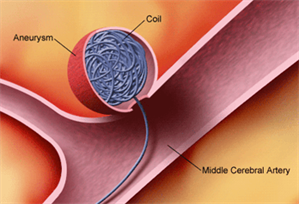Treatment for Brain Aneurysm

Specific treatment for a brain aneurysm will be determined by your doctor based on:
- Your age, overall health, and medical history
- Extent of the condition
- Your signs and symptoms
- Your tolerance for specific medications, procedures, or therapies
- Expectations for the course of the condition
- Your opinion or preference
 Depending on your situation, the doctor will make recommendations for the
intervention that is appropriate. Whichever intervention is chosen, the
main goal is to decrease the risk of subarachnoid hemorrhage, either initially
or from a repeated episode of bleeding.
Depending on your situation, the doctor will make recommendations for the
intervention that is appropriate. Whichever intervention is chosen, the
main goal is to decrease the risk of subarachnoid hemorrhage, either initially
or from a repeated episode of bleeding.
Many factors are considered when making treatment decisions for a brain aneurysm. The size and location of the aneurysm, the presence or absence of symptoms, the patient's age and medical condition, and the presence or absence of other risk factors for aneurysm rupture are considered. In some cases, the aneurysm may not be treated and the patient will be closely followed by a doctor. In other cases, surgical treatment may be indicated.
Pipeline Embolization for Large, Giant and Wide-Necked Aneurysms
 Large, giant and wide-necked aneurysms can be challenging to treat with
traditional methods. The pipeline embolization is a new treatment option
for large or giant aneurysms with wide necks. Endovascular coiling and
open neurosurgical clipping only repair the aneurysm. They do not treat
the actual blood vessel, the walls of which became weak and an aneurysm
was formed. Pipeline endovascular reconstruction has revolutionized the
way we treat cerebral aneurysms. Only a few centers throughout the country
have such technology or have physicians trained and certified to perform
this procedure.
Large, giant and wide-necked aneurysms can be challenging to treat with
traditional methods. The pipeline embolization is a new treatment option
for large or giant aneurysms with wide necks. Endovascular coiling and
open neurosurgical clipping only repair the aneurysm. They do not treat
the actual blood vessel, the walls of which became weak and an aneurysm
was formed. Pipeline endovascular reconstruction has revolutionized the
way we treat cerebral aneurysms. Only a few centers throughout the country
have such technology or have physicians trained and certified to perform
this procedure.
Endovascular Coiling or Coil Embolization
Endovascular coiling is a minimally invasive technique, which means an incision in the skull is not required to treat the brain aneurysm. Rather, a catheter is advanced from a blood vessel in the groin up into the blood vessels in the brain. Fluoroscopy (live X-ray) is used to assist in advancing the catheter to the head and into the aneurysm.
Once the catheter is in place, very tiny platinum coils are advanced through the catheter into the aneurysm. These tiny, soft, platinum coils, which are visible on X-ray, conform to the shape of the aneurysm. The coiled aneurysm becomes clotted off (embolization), preventing rupture. This procedure is performed either under general or local anesthesia.
Open Craniotomy (Surgical Clipping)
Open craniotomy (surgical clipping). This procedure involves the surgical removal of part of the skull. The physician exposes the aneurysm and places a metal clip across the neck of the aneurysm to prevent blood flow into the aneurysm sac. Once the clipping is completed, the skull is secured back together.
Click here to request more info about the Brain Aneurysm Program online or call us at 1-888-724-7123.



